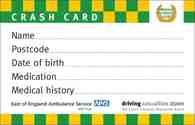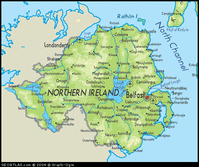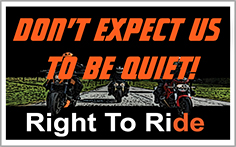CRASH card UK
CRASH Card is a scheme has been in use for nearly two years in England. Motorcyclists are encouraged to place a card inside their crash helmet as a medic alert. This card holds valuable information to aid treatment from the ambulance service encase of an accident. The CRASH card saves valuable time and speeds up tailored treatment for an individual. The CRASH card scheme is especially effective if the rider is unconscious or unable to communicate.
CRASH card creation

The UK CRASH card was created by the committee of the Ambulance Motorcycle Club. The card has a mnemonic “CRASH” which gives helpful advice if a rider comes across a road traffic collision. CRASH is an excellent way of helping the emergency services get the right resources to the scene as quickly as possible.
In the UK the CRASH card is accompanied by an explanatory letter which contains a self adhesive green dot. The letter explains that riders should affix the dot to the right hand side of their helmets or visor to help alert the attending medical staff to the presence of the card. The letter also shows how to fill out the card and explains that only trained professionals should remove an injured rider’s crash helmet.
In the UK the CRASH card is accompanied by an explanatory letter which contains a self adhesive green dot. The letter explains that riders should affix the dot to the right hand side of their helmets or visor to help alert the attending medical staff to the presence of the card. The letter also shows how to fill out the card and explains that only trained professionals should remove an injured rider’s crash helmet.
Some Facts

This information came from the research commissioned by the Department of the Environment’s Road Safety Division.
In total, 4,416 separate collisions involving a motorcycle were recorded in the period between 1st April 1998 and 31st March 2008. In total, there were 5,522 casualties accounted for across the ten-year period (1,689 killed or seriously injured).
Over the ten-year period from 1998 to 2007, all motorcycle collisions accounted on average for 6.9% of the total number of all collisions in Northern Ireland, and just over 13% of Killed and Seriously Injured (KSI) collisions. Throughout the 10 years, fatal motorcycle collisions as a proportion of total collisions in Northern Ireland has increased in general. The proportion of Motorcycle KSI collisions has steadily increased throughout the 10-year period from 1998 to 2007. Less than half of KSI motorcycle causalities were responsible for the collision in which they were involved (46.4%). Overall less than 32% of all motorcycle casualties were responsible for the collision.
The Department of The Environment (DOE) reports that the number of people killed on Northern Ireland’s roads last year was the lowest since records began
in 1931. The figures reported show the number of people killed in accidents in NI fell from 115 in 2009 to 55 in 2010, representing a 50% fall in fatalities
and a 20% reduction in serious injuries. Of the 55 people killed in 2010, 10 were pedestrians, 10 on motorcycles and the rest in other vehicles. The 10 motorcycle deaths were 8 riders and 2 pillions. However there has been a 60% reduction in fatalities since 2004.
The Environment Minister Edwin Poots said the 50% reduction in fatalities was welcome, but warned against complacency. ”We cannot dwell on our achievements
and we cannot be satisfied by 55 deaths and hundreds of seriously injured people. Even one life is one too many. There is a greater prize to be had – zero
road casualties,” he said.
On the back of Environment Minister Edwin Poots comments. We aim to bring the CRASH Card scheme to Northern Ireland and help in reducing road fatalities of riders and pillions alike.
In total, 4,416 separate collisions involving a motorcycle were recorded in the period between 1st April 1998 and 31st March 2008. In total, there were 5,522 casualties accounted for across the ten-year period (1,689 killed or seriously injured).
Over the ten-year period from 1998 to 2007, all motorcycle collisions accounted on average for 6.9% of the total number of all collisions in Northern Ireland, and just over 13% of Killed and Seriously Injured (KSI) collisions. Throughout the 10 years, fatal motorcycle collisions as a proportion of total collisions in Northern Ireland has increased in general. The proportion of Motorcycle KSI collisions has steadily increased throughout the 10-year period from 1998 to 2007. Less than half of KSI motorcycle causalities were responsible for the collision in which they were involved (46.4%). Overall less than 32% of all motorcycle casualties were responsible for the collision.
The Department of The Environment (DOE) reports that the number of people killed on Northern Ireland’s roads last year was the lowest since records began
in 1931. The figures reported show the number of people killed in accidents in NI fell from 115 in 2009 to 55 in 2010, representing a 50% fall in fatalities
and a 20% reduction in serious injuries. Of the 55 people killed in 2010, 10 were pedestrians, 10 on motorcycles and the rest in other vehicles. The 10 motorcycle deaths were 8 riders and 2 pillions. However there has been a 60% reduction in fatalities since 2004.
The Environment Minister Edwin Poots said the 50% reduction in fatalities was welcome, but warned against complacency. ”We cannot dwell on our achievements
and we cannot be satisfied by 55 deaths and hundreds of seriously injured people. Even one life is one too many. There is a greater prize to be had – zero
road casualties,” he said.
On the back of Environment Minister Edwin Poots comments. We aim to bring the CRASH Card scheme to Northern Ireland and help in reducing road fatalities of riders and pillions alike.
Right to Ride

Right To Ride is supporting our motorcycle safety initiative, the Motorbike Crash Cards for Northern Ireland (MCCNI) would like to thank them for all their support to introduce a CRASH Card scheme to Northern Ireland.
Why not visit their website and give them your support as we did
http://www.righttoride.co.uk/
Why not visit their website and give them your support as we did
http://www.righttoride.co.uk/
